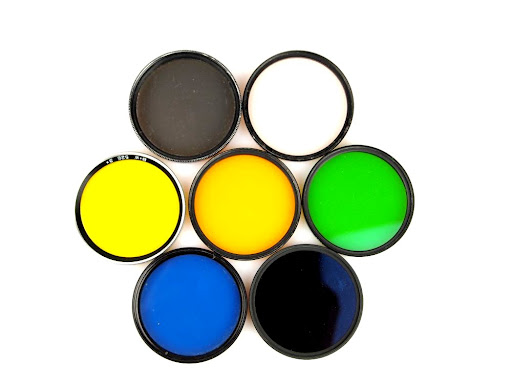Im digitalen Fotozeitalter sind sie fast ausgestorben, denn Software oder
der Bildprozessor in der Kamera kann in vielen (aber nicht allen!) Fällen
ihre Funktion übernehmen: die Rede ist von fotografischen Filtern. Oben auf
dem Bild ein Ausschnitt aus meiner Filtersammlung, die anderen, die ich
noch zusätzlich besitze sind entweder doppelt oder haben lediglich ein
anderes Filtergewinde. Von links oben nach rechts unten sind das...
1) Polfilter, der Filter schlechthin. Mehr dazu in einem zukünftigen Post.
2) Skylight-Filter. Habe ich einige, meist als ständiger Frontlinsenschutz
auf dem Objektiv. Der Filter ist ganz leicht rötlich und entfernt so
bläuliche Streustrahlung (Dunst) aus den Fotos.
3) Gelb-, 4) Orange- und 5) Grün-Filter, für die Schwarz-Weiß Fotografie,
s.u.
6) ein blauer Kunstlichfilter, ermöglicht gelbsticharme Aufnahmen bei
Glühlampenlicht auf Tageslichfilm. Kann man sich in Zeiten eines digitalen
und automatischen Weißabgleichs kaum noch vorstellen.
7) Infrarotfilter, ganz was Spezielles, auch dazu gibt es einen eigenen Post.
They are almost extinct in the digital photo era, because software or the
imaging processor in the camera can be used instead (at least in most
cases). I'm talking about photographic filters. The image shows some out of
my collection, the others I own in addition are either duplicates or just
have another filter thread.
From top left to bottom right there are ...
1) polarizing filter, THE filter per se. More about that in a future post.
2) Skylight filter. I have some, mostly as a permanent lens protection. The
filter is slightly reddish and removes scattered radiation (haze) from the
photos.
3) yellow, 4) orange and 5) green filter, for black and white photography,
see below
6) a blue incandescent light filter, allows shooting natural colors under
incandescent lighting on daylight film. This need is hard to imagine in
times of digital and automatic white balance.
7) Infrared filter, something quite special, also has its own post.
Um zu demonstrieren, welchen Effekt die farbigen Filter bei
Schwarz-Weiß-Fotos zeigen, habe ich mal ein
farbiges Digitalfoto genommen und genau solche Filter angewendet. Denn
einen farbigen Filter zu benutzen heißt nichts anderes als die jeweiligen
Komplementärfarben zu blocken. Man kann das mit einem
Fotobearbeitungsprogramm ganz einfach nachstellen. Beispiel Gelbfilter: Man
nimmt ein Farbfoto und setzt einfach den blauen Farbkanal auf Null. Das
Bild erscheint dann sehr gelb. Wenn man dieses dann nach SW konvertiert,
d.h. alle Farbsättigung rausnimmt bekommt man das selbe Ergebnis als wenn
man durch den Gelbfilter fotografiert hätte.
Wie man sieht, haben die farbigen Filter einen Effekt auf die
Grautonwiedergabe und können somit gestalterisch eingesetzt werden.
Allgemein kann am sagen, dass die Farbe des Filters verstärkt (also heller
dargestellt) wird, ähnliche Farben werden besser differenziert, die
Komplementärfarbe wird jedoch abgeschwächt (dunkler dargestellt). Weitere
Infos gibt es hier
(SW-Fotografie) und hier (andere
nützliche Filter).
For demonstration what effect the colored filters would do to a black and
white photo, I took a
digital photo and applied such filters virtually. Using a color filter
is nothing else than blocking the respective complementary color. You can
easily simulate this with a photo editor. For example the yellow filter:
simply set the blue color channel to zero. The image will then appear very
yellow. Converting this to B&W yields the same result as if you'd taken
the photo through a yellow filter.
As you can see, the color filters have an effect on the distribution of the
different grey levels and can be used creatively. General, as a rule of
thumb: Colors similar to the filter color will be amplified (ie brighter)
and get a better differentiation, the complementary colors become
darker. More information can be found here
(SW Photography) and here (other
useful filters) .



Keine Kommentare:
Kommentar veröffentlichen